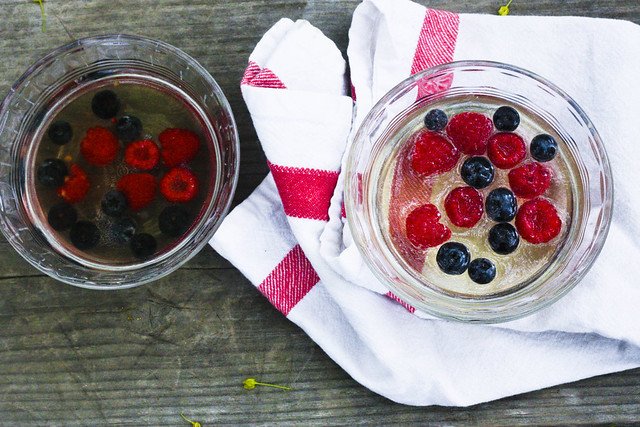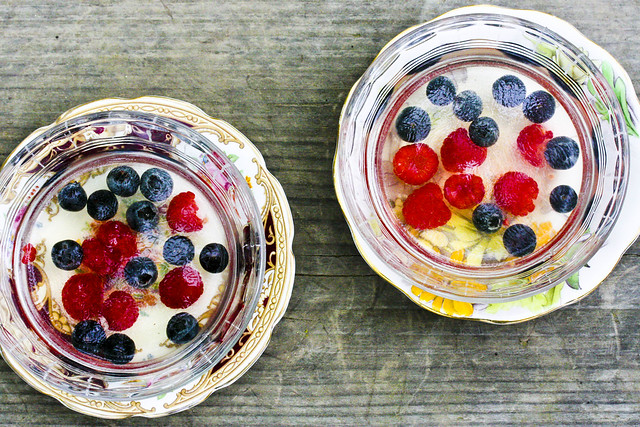Champagne Gelées
Are you the type of person who reads cookbooks in bed? You know, when you should be reading novels? Be honest, do you have a stack of them on your night table? Oh, uh, me either... Okay, yes I do. I do. I read them live novels, fantasize about their pictures, read all the recipe headings. I know for a fact I'm not the only one, because I've heard of other people on the interwebs doing the same thing. Granted, I've never met one of these people in real life, but that's the beauty of the internet. Brings us together. So my latest bed-side read is Sugarbaby, by Gesine Bullock-Prado. In the headnote for her luscious-looking Bitterwseet Pudding Pops, Bullock-Prado admits that when she babysat, she didn't do it for the money, but for the food. She claims to have gotten "the little stinkers to bed by reading bedtime stories so fast you could hear a sonic boom, and then [she'd] eat that poor family out of house and home." Myself? I was never so brazen. I ate just a little, but of everything.
So I'll be upfront right now that I was sent this book as a review copy. But after thumbing through it and falling in love with Bullock-Prado's anecdotes, I bought her first book, a novel with recipes, called Confections of a Closet Master Baker for a plane ride. So, the book. It's all about sugar (shocking, given its title). And sugar can be intimidating stuff. It burns, it hardens, it bubbles and sputters. It requires measuring, sometimes. And sometimes, constant watching. But, I mean, you're going to be undertaking these projects with a woman who cops to ravaging her neighbors' pantry without shame.
The book takes you through the several stages of sugar, from the simple dissolve to the thread stage, through the soft- firm- and hard-ball stages, and on to the soft- and hard-crack stages. (Now, those are fancy-sounding terms. Good to get them demystified.) There are recipes for each stage along the way, like homemade Sugar daddies from the soft-crack stage taffy from the firm-ball stage. True, many of the recipes require a candy thermometer, but I've never regretted buying mine, as they come in handier than you might think.
For our foray into the book, I chose two recipes, one simple and one slightly less simple. Let's start easy. I made these Champagne Gelées, or as Bullock-Prado calls them, G's Gelée Shots, for that same Mother's Day lunch I've been prattling on about. I wanted something light after a big meal, but springy, and festive without being a huge project since I wasn't cooking in my kitchen. What could possibly fit the bill better than fresh spring berries suspended in a gelée made from champagne? Nothing, that's what. (And we all know what a nut I am over gelées.) If you don't have or don't want to use champagne, Bullock-Prado suggests hard apple cider. But for Mothers Day? Champagne is the way to go. Remember, the alcohol is not cooked out of this dessert, so no giving it to children. That's why she calls them 'shots'.
UPDATE: There is also a companion site to the book, where the author offers further photos, tips and tricks to go along with the recipes!
G's Gelée Shots
Excerpted (with permission) from Sugarbaby by Gesine Bullock-Prado, 2011. Stewart, Tabori & Chang
2 cups (480 ml) champagne
1/2 cup (100 g) sugar
1 packet (7 g) unflavored gelatin
Fresh berries or other fruits, to taste
1. In a medium saucepan over medium heat, combine 1 1/2 cups (360 ml) of the champagne and the sugar. Allow to simmer until the sugar has completely dissolved.
2. Pour the remaining champagne into a small bowl and sprinkle the gelatin evenly over the liquid. Allow the gelatin to bloom, which usually takes about 1 minute. It should look soggy.
3. Remove the champagne mixture from the heat, scrape the gelatin mixture into the still-hot champagne, and stir until the gelatin has completely melted.
4. Pour the liquid gelée mixture into a 6-cup (48 oz) gelatin mold or divide evenly into 8-ounce ramekins and tap the ramekins firmly on a tabletop to release any air bubbles.
5. If you are planning on suspending anything in your gelée such as heavy fruit or fruit gummis, fill the gelatin mold or each ramekin half-way and allow to set in the refrigerator; this will take up to 1 hour. Leave the remaining gelatin at room temperature. If it solidifies, gently reheat over low heat until it becomes fluid, then cool completely (otherwise, it will melt the set gelatin when you pour it over the first layer). Place your desired ingredient(s) on top of the set gelée, pour the unset gelatin evenly over the suspended ingredient(s), and refrigerate until the second layer is set. If you wish to add something light, such as small berries, fill the dish or the ramekins halfway and add the ingredient(s) - they'll float to the top. Refrigerate until the gelée is set, then fill with the remaining mixture and refrigerate overnight.
* A Note from the Sugar Baby: I have one warning for you: Do not add fresh pineapple, kiwi, figs, guava, papaya, passion fruit or ginger root to the gelée. All of these otherwise wonderful things contain the enzyme bromelain, which will break down the gelatin and turn the gelée runny. Cooking those fruits to 158F (70C) deactivates the bromelain, so canned pineapple and most commercial purées should be okay, since they are typically heat-pasteurized.





Comments
Sues
and I love Sugar Baby - Gessine is a goddess